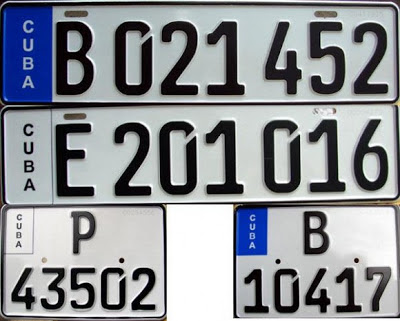 |
Possible prototypes of Cuba's new markers. Images: www.kubafotos.com |
For a decade, Cuba's colour-coded licence plates have been a highly visible part of the island's automotive scene.
But this month, Cuba begins the retirement of the system that allowed an observer – let's say a motorcycle cop tucked behind a "Patria O Muerte" billboard – to know from a distance whether a car was privately owned (yellow plate, good to ticket), rented by a tourist (red, even better) or operated by a government agency such as the all-powerful Ministry of the Interior (green, uh uh).Now, all privately owned cars, trucks and motorcycles will wear plates with black letters on a white background. State-owned vehicles get the same drab, two-colour scheme, but with a dab of blue on the side or in a corner.
And this isn't the only change. Cuba's licence plates have long conformed to the rectangular, six-by-12-inch (155 by 305 millimetres) format used in much of the Western Hemisphere. The new plates, at 4.3 inches (110 mm) high and 16.5 inches (420 mm) wide, are closer in proportion to the strip-like registration plates of Europe.
In pictures published at www.kubafotos.com, the new tags carry only a simple "CUBA" in vertical block letters to the left of the registration number. Those examples, however, could be prototypes; according to the country's Official Gazette, which announced details of the changes, the final products will bear both the country name and a "laser-printed image" image of the island.
Why dump the multi-colour system in place since 2002? The Official Gazette says the change is intended to reflect government reorganization and economic reforms, as well as "new provisions on the exploitation, use and circulation of vehicles."
Rather vague, that, but we might take it to mean that a country that has recently loosened the rules on private vehicle ownership and is encouraging more citizens to start businesses now desires a more egalitarian look for its vehicle population.
Not that the licence hierarchy will disappear with the new alphanumeric registrations. The beginning letter will signify whether the vehicle is in government service (A for some departments, F for the army, M for the interior ministry), or belongs to a diplomatic mission (C,D,E), rental agency (T) or foreign national living in Cuba (K).
Other letters, continuing the system of current plates, could identify the province in which the vehicle is registered.
Additionally, vehicles in "protocol service" or used by foreign journalists will be required to display prominent, blue- or green-bordered decals on their windshields ("free press" in Cuba apparently meaning "freely visible").
The switch is also a chance for authorities to root out the actual owners of vehicles, many of which have changed hands, sometimes several times over, without benefit of paperwork. Full documentation will be required before new plates are issued, the government warns.
But why the Euro-style format? No explanation is offered, but we can guess that Cuba wants to thumb its nose at its big neighbour to the north by rejecting still another of its conventions.
Given, however, that many Cuban drivers will be bolting their new plates to '53 Dodges, '57 Hudsons and other old, American-made iron, it could seem a rather hollow gesture.
 |
| Current private-ownership plate on a 1955 Oldsmobile. |
See also: